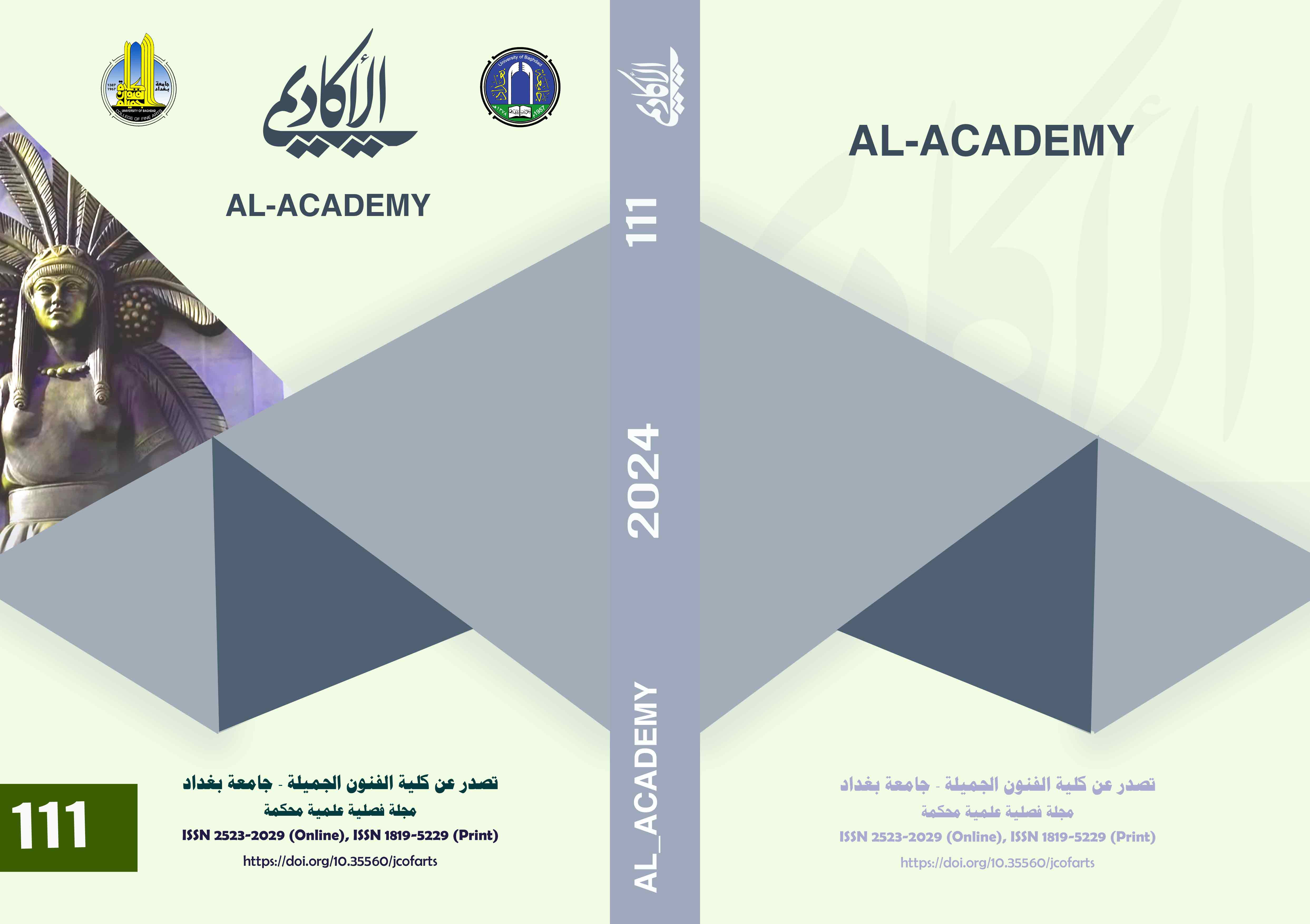السمات الجمالية لفن الديكوباج وتمثلاتها في نتاجات طلبة التربية الفنية
DOI:
https://doi.org/10.35560/jcofarts1179الكلمات المفتاحية:
السمات الجمالية، فن الديكوباجالملخص
تناول هذا البحث دراسة السمات الجمالية لفن الديكوباج وتمثلاتها في نتاجات طلبة التربية الفنية وجاءت الدراسة من اربعة فصول، مثل الأول الإطار العام للبحث والمتضمن المشكلة التي تضمنت التساؤل الاتي: ما هي السمات الجمالية لفن الديكوباج وتمثلاتها في نتاجات طلبة التربية الفنية؟
وفي أهمية البحث تطرق الباحثان الى الحاجة التي دفعتهما لتبني هذا الموضوع ، اما هدف البحث انطلق من العنوان والمشكلة وكما يأتي:
(الكشف عن السمات الجمالية لفن الديكوباج وتمثلاتها في نتاجات طلبة التربية الفنية).
وحدد الباحثان حدود البحث والتي تمثلت بطلبة قسم التربية الفنية / كلية الفنون الجميلة / جامعة بغداد 2022_2023م ، كما عرف الباحثان المصطلحات في ضوء طبيعة البحث الحالي، منها: ( السمة , الجمال , فن الديكوباج ) اصطلاحاً وإجرائياً، بعدها انتقل الباحثان الى الفصل الثاني، الذي ضم مبحثان تناول الأول دراسة مفهوم السمة الجمالية، متطرقاً الى بعض الأفكار الفلسفية التي تخص موضوع الجمال للمنجزات الفنية، وأيضا بما يتعلق ببعض الآراء الجمالية بين فلاسفة الجمال والفن وكذلك التطرق الى اهم السمات الجمالية ، فيما ناقش المبحث الثاني مفهوم فن الديكوباج وأهم أنواع هذا الفن ، وتطرق أيضا الى بعض العدد والأدوات المستخدمة ، وأستخرج الباحثان مؤشراتهما عن الإطار النظري الذي مثله هذا الفصل و ممهداً للفصل الثالث الذي ضم إجراءات البحث، فبعد التحقق من صدق أداة البحث والقيام بعدد من الاستبيانات الخاصة و المقابلات التي تساعد على مصداقية تحليل العينات ، وقد أشتمل الفصل الرابع على نتائج البحث والتوصيات والمقترحات ، ومن خلال ماسفرت عنه الدراسة وبعد عملية التحليل استعرض الباحثان نتائجهما ، وهي كالاتي :
1 - إتخذت السمات الجمالية ( الإنفعال الجمالي) أساساً لها في عملية التركيب الشكلي السياق السايكلوجي أو النفسي و السياق الجمالي الخالص .
2 - جاءت السمة الجمالية للمنجز الفني في فن الديكوباج وفق سياق ملمسي متباين وسياق خامي متباين (متنوع الخامات) .
كما توصل الباحثان في الى استنتاجات عدة بخصوص السمات الجمالية في المنجزات الفنية مستعرضاً بعدها المقترحات.
المراجع
Abbas, S. (2000). Ceramic Elements and Its Innovative Features. Misr: Dar Nahdet.
Abdul-Amir, A. (1996). Aesthetics of Form in Modern Iraqi Painting unpublished doctoral dissertation, College of Fine Arts. Baghdad: University of Baghdad.
AbdulHussein. (2001). attribute. cairo: Egypt.
AbuHatab, F. (1980). Mental Abilities (3rd ed.). Egypt: Anglo Egyptian Bookshop.
Al-Alfi, A. S. (1973). Brief History of Public Art. Cairo: he Egyptian General Book Authority.
albareiu. (2019). The concept and origins of the art of decoupage.
Al-Fahdawi. (2018). aesthetic features. baghdad: university of baghdad.
Al-Marayati, K. J. (2007). Ecological Psychology. House of Wisdom Journal(45).
Al-Moussawi, L. (2007). Sociology of Art, Ways of Seeing. (M. Al-Gohary, Trans.) Kuwait: The World of Knowledge.
Cooper, A. (2008). Culture, Anthropological Interpretation. (T. Fathi, Trans.) Kuwait: Knowledge World.
davis, D. (2000). Decoupage tools and supplies.
Eid, K. (1980). Aesthetics of Arts, The Small Encyclopedia. Dar Al-Hurriya for Printing.
Eisenberg, H. (2001). Interior Spaces. (A. A.-R. Al-Harith Abdel-Hamid, Trans.) Baghdad: House of Wisdom.
gnome. (2021). Types of decoupage art.
Ibrahim, L. H. (1969). Artistic Culture between Authenticity and Contemporaryness and its Role in Preparing the Art Teacher. Cairo: Fine Art Culture Conference.
Jihan. (2019). The concept and origins of the art of decoupage.
jocasta, i., & Walton. (1995). Decoupage tools and supplies.
Kobler, G. (1965). The Emergence of the Human Arts, A Study in the History of Things. (A. a.-M. al-Nashif, Trans.) Beirut: The National Institution for Printing and Publishing.
Lucie. (1975).
Mallens. (1993). The relationship between Gothic drawings and church drawings with modernity.
Nobler, N. (1987). Dialogue of Vision, An Introduction to Art Tasting and Aesthetic Experience. (J. I. Jabra, Ed., & F. Khalil, Trans.) Baghdad: Dar Al-Ma’moun.
pryce, M. (2015). The art of decoupage, a magical aesthetic way to hide imperfections.
Sorio, A. (1982). Aestheticism Through the Ages (2nd ed.). (M. Assi, Trans.) Beirut - Paris: Oweidat Publications.
wahba, m. (1974). Aesthetics. cairo: Egypt.
yunan. (1969). Characteristics of art in the twentieth century.
Jabbar Mohammed, H. (2022). Strategies of brain-based learning theory and its impact on the achievement of students of the Department of Art Education in Teaching Methods. Al-Academy, (106), 97–114. https://doi.org/10.35560/jcofarts106/97-114
Saleh Moraished, L., & Saleh Al-Saleh, M. (2022). The Relationship Between Using Diverse Materials to the Intellectual Context’s in the Art of Contemporary Ceramic. Al-Academy, (106), 253–270. https://doi.org/10.35560/jcofarts106/253-270
yassen jaleel , M., & Khazaal Baheel , J. (2022). Philosophy of values and its epistemological representations in industrial product design. Al-Academy, (106), 319–336. https://doi.org/10.35560/jcofarts106/319-336
Khazaal Baheel, J. ., & Abdul Jabbar Hameed Al- obaidi, shymaa . (2022). Interaction and functional structural transformation of product design. Al-Academy, (105), 81–104. https://doi.org/10.35560/jcofarts105/81-104
Saleh Mahdi Hussein, H., & Ahmed Al-Fahdawi, S. (2023). Classroom communication in art education lessons between concept and function. Al-Academy, (108), 77–92. https://doi.org/10.35560/jcofarts108/77-92
التنزيلات
منشور
إصدار
القسم
الرخصة
الحقوق الفكرية (c) 2024 Haneen ali salam , Malik hameed muhsin

هذا العمل مرخص بموجب Creative Commons Attribution 4.0 International License.













